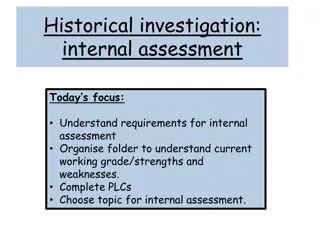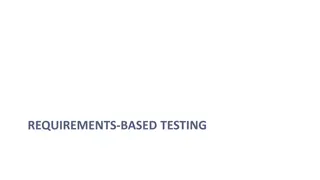Understanding Material Testing and Investigation Methods
Materials need to be tested before manufacturing to select the most suitable option. Comparability, environmental conditions, and consistent testing techniques are crucial. Simple workshop tests like tensile, toughness, hardness, malleability, and ductility tests can be conducted using basic tools to assess material properties.
Download Presentation

Please find below an Image/Link to download the presentation.
The content on the website is provided AS IS for your information and personal use only. It may not be sold, licensed, or shared on other websites without obtaining consent from the author. Download presentation by click this link. If you encounter any issues during the download, it is possible that the publisher has removed the file from their server.
E N D
Presentation Transcript
3. Methods for investigating and testing materials
Starter For 2 minutes, discuss on your tables and write in your book 0:00 0:01 0:02 0:03 0:04 0:05 0:06 0:07 0:08 0:09 0:10 0:11 0:12 0:13 0:14 0:15 0:16 0:17 0:18 0:19 0:20 0:21 0:22 0:23 0:24 0:25 0:26 0:27 0:28 0:29 0:30 0:31 0:32 0:33 0:34 0:35 0:36 0:37 0:38 0:39 0:40 0:41 0:42 0:43 0:44 0:45 0:46 0:47 0:48 0:49 0:50 0:51 0:52 0:53 0:54 0:55 0:56 0:57 0:58 0:59 1:00 1:01 1:02 1:03 1:04 1:05 1:06 1:07 1:08 1:09 1:10 1:11 1:12 1:13 1:14 1:15 1:16 1:17 1:18 1:19 1:20 1:21 1:22 1:23 1:24 1:25 1:26 1:27 1:28 1:29 1:30 1:31 1:32 1:33 1:34 1:35 1:36 1:37 1:38 1:39 1:40 1:41 1:42 1:43 1:44 1:45 1:46 1:47 1:48 1:49 1:50 1:51 1:52 1:53 1:54 1:55 1:56 1:57 1:58 1:59 2:00 Discuss why materials would need to be tested before manufacturing? STRETCH AND CHALLENGE Why may have you seen these terms before? give examples
Learning Objectives Understand how different materials can be tested Explain how material testing can impact a material Discuss the difference between workshop and industrial testing L/O Understand how different workshop tools can be applied and impacted on a material
Material testing Materials testing is used to help select the most appropriate material for a product or application. When testing different materials, the tests must be comparable (fair) Use the same size of material for each test Make sure the environmental conditions are the same Use the same testing equipment and technique (including force applied and position of force) Use one person to take all test measurements Exam tip State the purpose of the test, accurately label and describe how the test is carried out fairly.
Simple workshop tests Metals Simple workshop tests use basic tools and equipment Tensile, toughness, hardness, malleability and ductility tests are the main type of tests that can easily be performed in the workshop. Less deflection under load means the material has more tensile strength Toughness test: tough materials absorb impact, brittle materials bend or shatter Hardness test: the material is tested using a dot punch and force with a hammer, the smaller the indent the harder the material Malleability and ductility: when the test piece is bent to and angle of 90 degrees cracks on the outside indicate a lack of ductility, cracks on the inside indicate lack of malleability.
Simple workshop tests Create a test in your books which has 3 of the materials tested with the different types underneath. Find out which material is best Toughness test: tough materials absorb impact, brittle materials bend or shatter Malleability and ductility: when the test piece is bent to and angle of 90 degrees cracks on the outside indicate a lack of ductility, cracks on the inside indicate lack of malleability. Hardness test: the material is tested using a dot punch and force with a hammer, the smaller the indent the harder the material
Other types of tests Woods Corrosion testing Place equally sized material samples outside in an area exposed to the effects of weather and leave a set length of time. Materials can then be visually inspected for surface corrosion Electrical conductivity test Collect material samples of the same dimensions and mark a set distance to place the multimeter probes. Measure the resistance on the multimeter. The higher the resistance the lower the conductivity Typical mistake Don t describe an industrial testing method when a workshop testing method is asked for and remember to explain how the test results are interpreted.
Industrial testing Woods Industrial tests are usually carried out in a lab with specific testing machinery, using standardised test pieces of materials. Different industrial testing is used for a variety of different materials, knowing the difference between workshop test and industrial tests may be important for your exams. The video shown discusses certain types of tests that are important to understand and remember for your exam. As part of your understanding I want you to research and investigate the two different types of industrial testing as part of your home learning. Research the two testing aspects and produce a 500 word document on them The Izod impact test A tensometer machine























